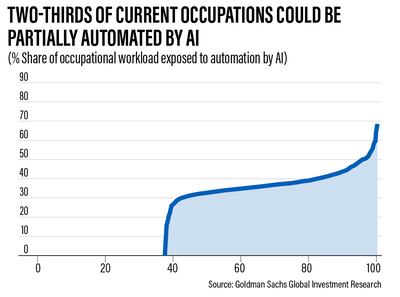The growing adoption of artificial intelligence technology can help boost global economic growth and raise labour productivity, a new report by Goldman Sachs has found.
The combination of significant labour cost savings, new job creation and higher productivity for non-displaced workers can lead to a productivity boom that raises economic growth "substantially", the US investment bank's analysts said in the report.
Widespread AI adoption can eventually boost annual global gross domestic product by 7 per cent in the 10 years after at least half of companies worldwide use AI technology.
The bank estimates that AI adoption could raise global annual productivity growth by 1.4 percentage points over a decade, although it expects a more delayed impact in emerging market economies.
"Although the impact of AI will ultimately depend on its capability and adoption timeline, this estimate highlights the enormous economic potential of generative AI if it delivers on its promise," said Goldman Sachs economists, led by Jan Hatzius.
The global AI market is projected to surpass $1.7 trillion in 2030, up from $93.5 billion in 2021, expanding at a compound annual growth rate of more than 38 per cent, data from Grand View Research indicates.
The Goldman Sachs report explores whether a rapid acceleration in task automation will drive labour cost savings and raise productivity.
Eighteen per cent of work globally could be automated by AI, with a bigger impact on developed than emerging markets, the report said.

In the US, economists estimate that "generative AI" may raise labour productivity by 1.5 percentage points per year over a decade following widespread adoption.
However, the boost "could be much smaller or larger depending on the difficulty level of tasks AI will be able to perform and how many jobs are ultimately automated", they said.
About two thirds of US occupations are exposed to some degree of automation by AI, with most having a significant — but partial — share of their workload (25-50 per cent) that can be replaced by AI, the report said.

In the US, a quarter of current work tasks could be automated by AI, with sectors most at risk including administrative (46 per cent) and legal (44 per cent) professions. Physically intensive professions such as construction and maintenance have low exposure.
In the US and Europe, the report found about two thirds of current jobs are exposed to some degree of AI automation, and that generative AI could substitute up to a quarter of current work.
Globally, generative AI could cost the world the equivalent of 300 million full-time jobs to automation across major economies, the report indicated. Lawyers and administrative staff would be among those at greatest risk of becoming redundant.

Goldman Sachs said if corporate investment in AI continues to increase at the more modest pace that software investment grew at during the 1990s, US investment in AI alone could approach 1 per cent of national GDP by 2030.
The bank said it assumes that AI would be capable of finishing tasks such as evaluating a complicated insurance claim for policy compliance, documenting the results of a crime scene investigation or completing tax forms for a small business.
However, it did not expect AI being adopted for more nuanced tasks such as making a court ruling, checking the status of a patient in critical care, studying international tax laws or determining the reaction of a virus to a new drug.


